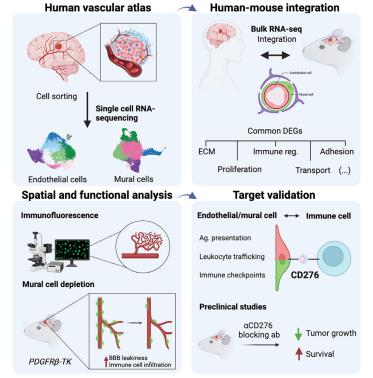Researchers from the University of Lausanne in Switzerland have published a research paper in the Cancer Cell journal titled “Interrogation of endothelial and mural cells in brain metastasis reveals key immune-regulatory mechanisms”.
Recent analysis of samples from patients with brain metastases (BrM) has revealed the importance of the brain tumor microenvironment (TME) in regulating the progression of primary and metastatic brain malignancies. The enormous complexity of TME in BrM is being revealed, with the immune cell landscape being the focus so far. However, there is currently a lack of comprehensive maps of human BrM vascular lumens.
The blood-brain barrier (BBB) is composed of endothelial cells (EC), parietal cells, astrocyte terminals, and closely related microglia. The tight junctions formed by endothelial cells serve as selective barriers, allowing necessary nutrients to enter while protecting the brain from pathogens and toxic substances. However, metastatic cancer cells can cross the BBB through different mechanisms, and after these cancer cells colonize the brain, they will alter their vascular system, forming a blood tumor barrier. Although this abnormal vascular system may cause infiltration of peripheral immune cells, including CD8+T cells, it does not induce a persistent immune response.
In this study, the research team conducted an in-depth analysis of key components of the vascular system in brain tumors. Single-cell RNA sequencing, batch RNA sequencing, and spatial tumor microenvironment (TME) imaging analysis were performed on vascular cells from human and mouse brain metastases (BrM) and non-tumor brain samples, and preclinical studies were conducted using BrM models to attempt to answer the following questions:
What is the heterogeneity of endothelial and parietal cells in BrM? What are the structural and molecular changes related to BrM in these vascular components? How do we target the BrM vascular system in treatment?
This study provides effective treatment strategies for these invasive tumors through a deeper understanding of BrM biology.
The analysis of this study showed significant differences in gene expression patterns between endothelial cells and parietal cells in brain metastases (BrM) and the same cells from non-cancerous brain tissue. This indicates that there are various distortions in the blood vessels of brain tumors, including intercellular connections and adhesion issues between endothelial and parietal cells, reflecting the well-known “leakage” of tumor blood vessels. These changes inhibit anti-tumor immune responses or induce self-killing of T cells targeting cancer cells.

The research team integrated the above experimental data with mouse models and created a platform for discovering therapeutic targets for BrM in the vascular system. An immunosuppressive molecule called CD276 has been discovered, which is particularly abundant in endothelial and parietal cells of brain metastases and can serve as an emerging target for cancer immunotherapy. CD276 is known to inhibit T cell proliferation, support the immune escape of cancer cells, and is associated with poor prognosis in cancer patients.
The research team further confirmed that the antibody targeting CD276 can inhibit the growth of brain tumors in the breast cancer mouse model and significantly prolong its survival time. In addition, this treatment also altered the vascular structure at the molecular level and promoted the entry of cytotoxic T cells into the tumor.
The research team stated that in addition to identifying CD276 as a potential therapeutic target for brain metastases, this study also provides important insights into the complex interactions between the vascular system, immune cells, and cancer cells, which is of great translational significance for developing therapeutic interventions for brain metastases.
Reference
Bejarano et al., 2024, Cancer Cell 42, 1–18, March 11, 2024